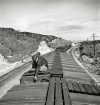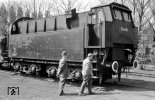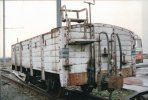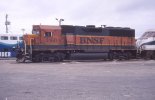You are using an out of date browser. It may not display this or other websites correctly.
You should upgrade or use an alternative browser.
You should upgrade or use an alternative browser.
Prototype Tim Mills' Photos
- Thread starter oldravendale
- Start date
Roger Pound
Western Thunderer
Please excuse this question on your thread, Brian, but this interesting information on 'Kabintenders' has left me wondering if I have seen similar arrangements in the days of steam across the pond on US railways. And no, I am not thinking of those locos with the driving cabin mounted half-way down the boiler (known as 'camel-backs'). It is just something that I seemed to have dredged up from the back of my mind - or on the other hand perhaps senility is really setting in .........  !
!
Roger
 !
!Roger
oldravendale
Western Thunderer
I'm still away housekeeping the thread, Roger, but please ask the question on here. (Oh, you have! ). I really enjoy this being the source of rabbit holes....
). I really enjoy this being the source of rabbit holes....
Brian
 ). I really enjoy this being the source of rabbit holes....
). I really enjoy this being the source of rabbit holes....Brian
timbowales
Western Thunderer
Roger, senility is not setting in yet!Please excuse this question on your thread, Brian, but this interesting information on 'Kabintenders' has left me wondering if I have seen similar arrangements in the days of steam across the pond on US railways. And no, I am not thinking of those locos with the driving cabin mounted half-way down the boiler (known as 'camel-backs'). It is just something that I seemed to have dredged up from the back of my mind - or on the other hand perhaps senility is really setting in .........!
Roger
Traditionally US train crews had more members than here in the UK.
1) There would be the Conductor who was in charge of the train and rode in the caboose/van/crummy at the rear. He would be accompanied by one or more brakemen.
2) The Engineer and fireman rode on the locomotive. In addition there would be a Head End Brakeman as well.
Some roads built cabs big enough to seat three people whilst some, such as the Pennsylvania, did what you are thinking of and built a brakeman’s cabin into the tender.
HTH
Tim T
AndyB
Western Thunderer
As there have been lots of pictures inside Old Oak Common shed, this report may be of interest -
https://learninglegacy.crossrail.co...edBuiltHeritageRecordingof70Turntable-2.0.pdf.
Apologies if it has been identified before - I didn't a quick search on here and didn't find it.
Andy
https://learninglegacy.crossrail.co...edBuiltHeritageRecordingof70Turntable-2.0.pdf.
Apologies if it has been identified before - I didn't a quick search on here and didn't find it.
Andy
David Waite
Western Thunderer
Thanks Andy that’s a very interesting article, On Figure 8 ( which is a plan ) there is a section with the heading speeds, it states the TT speed is 32.5 seconds my eyes cannot see what is written for the covered distance in that time I assume it says 180 degrees but I’m not sure could someone verify that for me.As there have been lots of pictures inside Old Oak Common shed, this report may be of interest -
https://learninglegacy.crossrail.co...edBuiltHeritageRecordingof70Turntable-2.0.pdf.
Apologies if it has been identified before - I didn't a quick search on here and didn't find it.
Andy
David.
Roger Pound
Western Thunderer
I am extremely obliged Tim - the old memory might be getting a bit frayed round the edges, but it would still seem to function - perhaps just on one and a half cylinders these days,Roger, senility is not setting in yet!
Traditionally US train crews had more members than here in the UK.
1) There would be the Conductor who was in charge of the train and rode in the caboose/van/crummy at the rear. He would be accompanied by one or more brakemen.
2) The Engineer and fireman rode on the locomotive. In addition there would be a Head End Brakeman as well.
Some roads built cabs big enough to seat three people whilst some, such as the Pennsylvania, did what you are thinking of and built a brakeman’s cabin into the tender.
HTH
Tim T
 . It was undoubtedly the Pennsylvania locos I vaguely remembered from my days way back when researching Penn, NYC and PC. I dabbled with US H0 on and off over the years but I'm back to Germany with my next idea - I find that slightly safer ground.......
. It was undoubtedly the Pennsylvania locos I vaguely remembered from my days way back when researching Penn, NYC and PC. I dabbled with US H0 on and off over the years but I'm back to Germany with my next idea - I find that slightly safer ground....... .
.Roger.
mickoo
Western Thunderer
BNSF rebuilt (or had built from factory) some GP50's with five man cabs.Roger, senility is not setting in yet!
Traditionally US train crews had more members than here in the UK.
1) There would be the Conductor who was in charge of the train and rode in the caboose/van/crummy at the rear. He would be accompanied by one or more brakemen.
2) The Engineer and fireman rode on the locomotive. In addition there would be a Head End Brakeman as well.
Some roads built cabs big enough to seat three people whilst some, such as the Pennsylvania, did what you are thinking of and built a brakeman’s cabin into the tender.
HTH
Tim T
Most modern steam (1940's onward) engines had three seats but many also had tender cabins as well.
All modern diesels have three seats, probably from the 70-80's onward (though I think the third seat was a railroad fitted option but I think usually fitted), certainly EMD spartan cabs, Driver, conductor and Brake man.
In steam days brake men where tasked with setting and releasing individual brakes on each piece of rolling stock, hence roof walkways and brake stands accessible from the top whilst in motion; having a head and tail brake man sped up this process and enabled faster transit times. For practical reasons roof top brake setting was usually carried out on fast manifest of block unit trains, reefers, livestock, perishables etc, it didn't work so well with mixed manifest with gondolas, flats and tanks, those would run slower and be set at the top of the grade from the ground whilst stationary.

N&W and D&RGW also had tender cabins, often called 'dog houses' and I'm sure there were other railroads that had them.
Apologies for the diversion

Last edited:
Arun Sharma
Western Thunderer
I think it is right and proper that the HS2 organistion should have embedded Museum of London, English Heritage, National Trust, British Museum etc., folk in it as, in the past, [most] earthworks have generally either been fairly close to the surface or less attention has been paid to artefacts and processes uncovered - although there have been many notable exceptions particularly in the 'Square Mile'. However, such research and its attendant diversions in time and place aren't free and a significant proportion of the budget of HS2 has been spent in hiding present-day human activities as well as uncovering and recording past ones.As there have been lots of pictures inside Old Oak Common shed, this report may be of interest -
https://learninglegacy.crossrail.co...edBuiltHeritageRecordingof70Turntable-2.0.pdf.
Apologies if it has been identified before - I didn't a quick search on here and didn't find it.
Andy
But, it seems to me, too many folk have leapt on the 'anti-' bandwagon and slagged off the costs of HS2 wthout accepting that their actions, NIMBYism and complaints have caused costs to rise - and then they whine about the cost!
Roger Pound
Western Thunderer
Mention HS2 and I immediately reflect on the ridiculous running down to initiate closure of the former Great Central main line, recalling the standards to which that line was built, not to mention it's route. I'll leave it there........
Roger.
Roger.
Brian Daniels
Western Thunderer
oldravendale
Western Thunderer
According to my info, neither. Recorded as Oxley x/11/61.
Just for reference, the storage location is a surmise pending works attention at possibly Stafford Road during 1959, I have nothing further that helps.
2888 Pontypool Rd 11/48, Severn Tunnel Junc 1/53, Llanelly 8/58, Stored (poss Llanelly) 11/58, Oxley 2/59, Tyseley 3/59, Stourbridge 4/59, Oxley 4/61, Banbury 11/61, Wdn 2/63.
Martin
Hello again Martin. I'm following this up because I'm currently updating the detailed info following posting of Tim's pictures and I suspect I misread the meaning of "Oxley x/11/61". Looking at this along with the other detail you've kindly provided I think the "Oxley x/11/61" refers to the transfer date to Banbury and not, as I first thought, the withdrawal date. Sorry for putting you to the trouble but would you confirm for me, please? If I'm correct everything neatly falls in to place.
Thanks for your continuing input. I can't guarantee there won't be "more questions arising".
Brian
Yorkshire Dave
Western Thunderer
Dave is correct, it's a Kabin tender, there are several variants but this is by far the most common 'production' variant, the others are small or single test builds.
This is another one of the prototype Kabintenders 'Rucksackform'. Never perpetuated due to being too dangerous for the Zugführer in the event of a collision. Eisenbahnstifung Foto: A. Dormann, Slg. W. Löckel 04/1957.

Martin Shaw
Western Thunderer
Poor english on my part Brian, I was countering Dogstar's comment re Dec 61 or 62, that 2888 had left Oxley for Banbury on a day in Nov61., and I have amended my post to reflect this. I suspect more accurate date could be provided by the RCTS.Hello again Martin. I'm following this up because I'm currently updating the detailed info following posting of Tim's pictures and I suspect I misread the meaning of "Oxley x/11/61". Looking at this along with the other detail you've kindly provided I think the "Oxley x/11/61" refers to the transfer date to Banbury and not, as I first thought, the withdrawal date. Sorry for putting you to the trouble but would you confirm for me, please? If I'm correct everything neatly falls in to place.
Thanks for your continuing input. I can't guarantee there won't be "more questions arising".
Brian
Regards
Martin
oldravendale
Western Thunderer
Thanks Martin. That clarification really helps.
Thank you to so many for the really interesting comments attached to the recent photos. I will honestly get to deal with them and respond further when I start putting some more photos up on this thread (I hope that won't be too far way) but in the meantime there's been something gnawing away at me and that's the difficulty of preserving all the information which appears on this thread. I gave my self a good talking to and decided that I'd have to spend some housekeeping time collating all the data. I've also been having a conversation about how it may be possible to conserve the photos outside the regular run of the British photos, for example the German ones which have been introduced recently and which seem to have created quite a stir. I’m working on this issue separately.
Incidentally, in going through all the comments and additional data it's obvious I've been very mean with making the "Like" comments to so many. I really appreciate all that the interested parties provide and will try to do better in acknowledging that help.
Well, I think I've found a vehicle for recording our comments. It's a bit clunky but easy to do and I can include everything - maps, photos etc. I believe this helps the record to become a valuable one, particularly as you can see the too and fro of the comments. My example is courtesy of so many who commented and researched "that wall" at Monument Lane shed. The comments are recorded against the photo img number so it appears within the photo record. Here's what I mean:
The photo which kicked all this off was a question by HRMSPaul about a shot of a G2a at Monument Lane, img2557 in post #2905 but further inspection of the image in question and the relevant "bridge" showed it to be a 2P, img2556 which was recorded thus:
Another 2P 4-4-0 40678 in Monument Lane Yard between May and August 1961. This was a Bescot engine since November 1959 and was withdrawn on 8th July 1961. (SLS). It was scrapped in September at Cashmore's Great Bridge. (BR Database).
So, attached to this is a pdf of all the info which flowed in after the question had been asked. I’m still a little uneasy that the comments are not attributed, although the sources when provided are. I’ll be grateful to know whether you as contributors would value the associated contributor attached to the comment or whether you are comfortable with these comments being “bald”. Contributor info can be added if it’s felt to be necessary although in some cases I’ll only be able to attach “nom de plume” where the actual title of the contributor is unknown.
This is gradually becoming not just a photo collection but potentially quite an important repository of associated information which would otherwise be lost.
Brian
Thank you to so many for the really interesting comments attached to the recent photos. I will honestly get to deal with them and respond further when I start putting some more photos up on this thread (I hope that won't be too far way) but in the meantime there's been something gnawing away at me and that's the difficulty of preserving all the information which appears on this thread. I gave my self a good talking to and decided that I'd have to spend some housekeeping time collating all the data. I've also been having a conversation about how it may be possible to conserve the photos outside the regular run of the British photos, for example the German ones which have been introduced recently and which seem to have created quite a stir. I’m working on this issue separately.
Incidentally, in going through all the comments and additional data it's obvious I've been very mean with making the "Like" comments to so many. I really appreciate all that the interested parties provide and will try to do better in acknowledging that help.
Well, I think I've found a vehicle for recording our comments. It's a bit clunky but easy to do and I can include everything - maps, photos etc. I believe this helps the record to become a valuable one, particularly as you can see the too and fro of the comments. My example is courtesy of so many who commented and researched "that wall" at Monument Lane shed. The comments are recorded against the photo img number so it appears within the photo record. Here's what I mean:
The photo which kicked all this off was a question by HRMSPaul about a shot of a G2a at Monument Lane, img2557 in post #2905 but further inspection of the image in question and the relevant "bridge" showed it to be a 2P, img2556 which was recorded thus:
Another 2P 4-4-0 40678 in Monument Lane Yard between May and August 1961. This was a Bescot engine since November 1959 and was withdrawn on 8th July 1961. (SLS). It was scrapped in September at Cashmore's Great Bridge. (BR Database).
So, attached to this is a pdf of all the info which flowed in after the question had been asked. I’m still a little uneasy that the comments are not attributed, although the sources when provided are. I’ll be grateful to know whether you as contributors would value the associated contributor attached to the comment or whether you are comfortable with these comments being “bald”. Contributor info can be added if it’s felt to be necessary although in some cases I’ll only be able to attach “nom de plume” where the actual title of the contributor is unknown.
This is gradually becoming not just a photo collection but potentially quite an important repository of associated information which would otherwise be lost.
Brian
Attachments
Last edited:
mickoo
Western Thunderer
That's a good idea, but a lot of work given how many photos there are.Thanks Martin. That clarification really helps.
Thank you to so many for the really interesting comments attached to the recent photos. I will honestly get to deal with them and respond further when I start putting some more photos up on this thread (I hope that won't be too far way) but in the meantime there's been something gnawing away at me and that's the difficulty of preserving all the information which appears on this thread. I gave my self a good talking to and decided that I'd have to spend some housekeeping time collating all the data. I've also been having a conversation about how it may be possible to conserve the photos outside the regular run of the British photos, for example the German ones which have been introduced recently and which seem to have created quite a stir. I’m working on this issue separately.
Incidentally, in going through all the comments and additional data it's obvious I've been very mean with making the "Like" comments to so many. I really appreciate all that the interested parties provide and will try to do better in acknowledging that help.
Well, I think I've found a vehicle for recording our comments. It's a bit clunky but easy to do and I can include everything - maps, photos etc. I believe this helps the record to become a valuable one, particularly as you can see the too and fro of the comments. My example is courtesy of so many who commented and researched "that wall" at Monument Lane shed. The comments are recorded against the photo img number so it appears within the photo record. Here's what I mean:
The photo which kicked all this off was a question by HRMSPaul about a shot of a G2a at Monument Lane, img2557 in post #2905 but further inspection of the image in question and the relevant "bridge" showed it to be a 2P, img2556 which was recorded thus:
Another 2P 4-4-0 40678 in Monument Lane Yard between May and August 1961. This was a Bescot engine since November 1959 and was withdrawn on 8th July 1961. (SLS). It was scrapped in September at Cashmore's Great Bridge. (BR Database).
So, attached to this is a pdf of all the info which flowed in after the question had been asked. I’m still a little uneasy that the comments are not attributed, although the sources when provided are. I’ll be grateful to know whether you as contributors would value the associated contributor attached to the comment or whether you are comfortable with these comments being “bald”. Contributor info can be added if it’s felt to be necessary although in some cases I’ll only be able to attach “nom de plume” where the actual title of the contributor is unknown.
This is gradually becoming not just a photo collection but potentially quite an important repository of associated information which would otherwise be lost.
Brian
One thing I'd perhaps suggest is putting the original photo at the top of the document, that way if WT did die for whatever reason then all that extra information has something to hang from, otherwise it's a not very useful if we don't know what we were all talking (relate to) about in the first place.
You also now have an extra back up of your work and everyone else's input, moving forward for those that may use this as research material the pdf can then be printed and collated in ones own archive for easy reference.
It may also pay to add something into the document title so that it actually means something, example here might be LMS or BR(M) G2a 49411-Monument Lane.
Like above, if WT dies no one has any clue what img2556 pertains to.
adrian
Flying Squad
I sincerely hope it doesn't die, I'm doing my best to avoid such a situation. I have backups of file systems and databases, locally stored not reliant on the hosting company, one of the benefits of a small forum. A full site backup currently stands around 35Gb which is just about manageable for me on an amateur basis to download over a home fibre broadband. I then place copies on a local NAS drive with mirrored drives and an external drive and finally a couple of latest copies on an iCloud account. Now if I could work out how to ftp the full backup to iCloud directly that would be even better.One thing I'd perhaps suggest is putting the original photo at the top of the document, that way if WT did die for whatever reason then all that extra information has something to hang from, otherwise it's a not very useful if we don't know what we were all talking (relate to) about in the first place.
You also now have an extra back up of your work and everyone else's input, moving forward for those that may use this as research material the pdf can then be printed and collated in ones own archive for easy reference.
It may also pay to add something into the document title so that it actually means something, example here might be LMS or BR(M) G2a 49411-Monument Lane.
Like above, if WT dies no one has any clue what img2556 pertains to.
Record keeping and archiving is something I'm acutely aware of and wish a simple solution were available. The fact can't be escaped that any solution requires quite a bit of effort. I keep looking at export threads to pdf options etc but have yet to find anything I'm happy with. The formatting and options always leave some thing to be desired. Always happy to learn of any available options or suggestions.
Barry37
Western Thunderer
Please excuse this question on your thread, Brian, but this interesting information on 'Kabintenders' has left me wondering if I have seen similar arrangements in the days of steam across the pond on US railways. And no, I am not thinking of those locos with the driving cabin mounted half-way down the boiler (known as 'camel-backs'). It is just something that I seemed to have dredged up from the back of my mind - or on the other hand perhaps senility is really setting in .........!
Roger
The rather basic accommodation on the Belgian metre-gauge SNCV wagons must have been a little chilly in the winter, too:Thanks Michael,
I wondered if “established working practice” had something to do with it.
it must have been a bit fresh in the sentry-box shelters on the older freight trains too…
cheers
Simon

SimonT
Western Thunderer
Brian,
a little more flesh on the 2888 bones from the BR WR Allocation books.
12Aug57 Llanelly, 22Oct58 Store (no more details), 16Jun59 Oxley, 3Feb58 Tysley, 14Mar59 Stourbridge, 24Sep59 shopped Wolverhampton (Repair), 9Oct59 Oxley, 6Jun60 shopped Wolverhampton (Repair), 11Aug60 Stourbridge, 12Apr61 Oxley, 28Nov61 Banbury, Jan63 LMR, 18Feb63 Cond.
a little more flesh on the 2888 bones from the BR WR Allocation books.
12Aug57 Llanelly, 22Oct58 Store (no more details), 16Jun59 Oxley, 3Feb58 Tysley, 14Mar59 Stourbridge, 24Sep59 shopped Wolverhampton (Repair), 9Oct59 Oxley, 6Jun60 shopped Wolverhampton (Repair), 11Aug60 Stourbridge, 12Apr61 Oxley, 28Nov61 Banbury, Jan63 LMR, 18Feb63 Cond.

